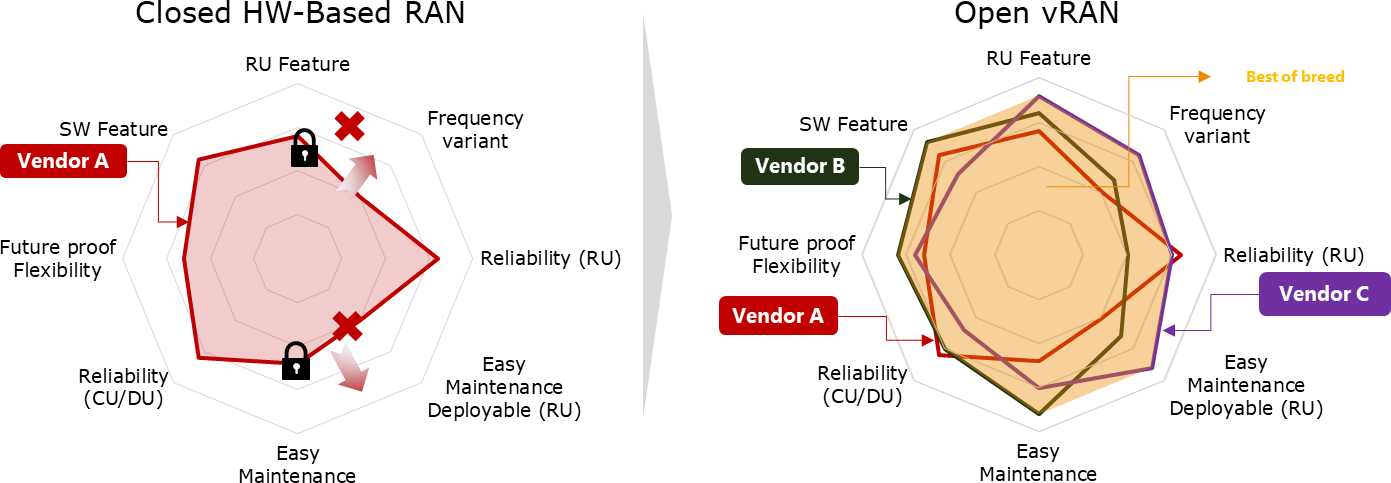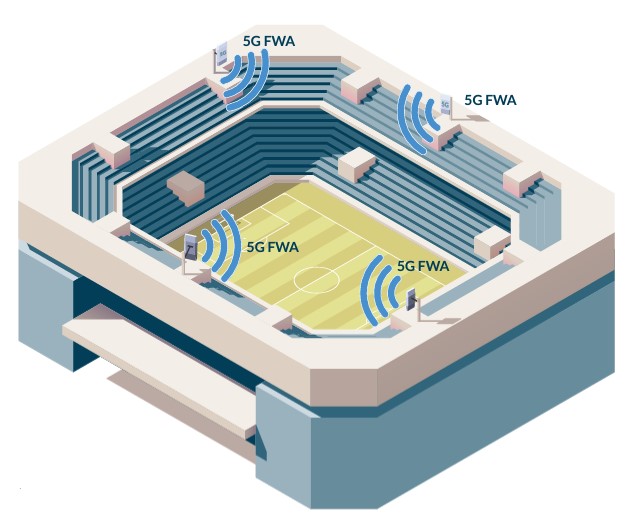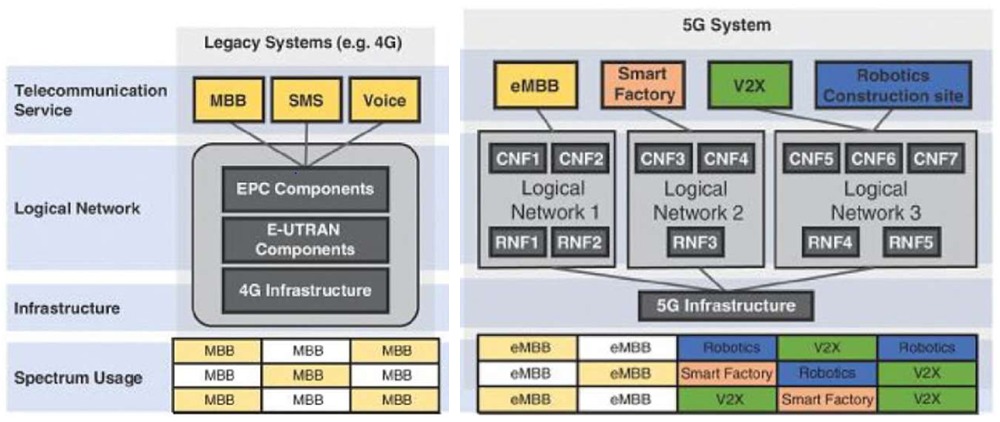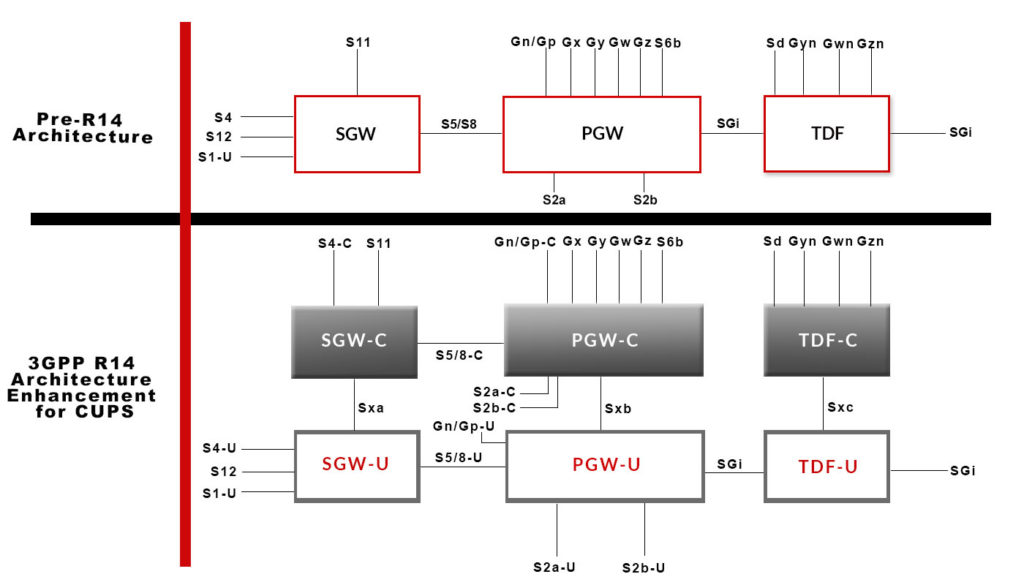Introduction
Mobile operators continue to build more capacity while driving down costs and looking for new service revenue opportunities. As they focus on 5G, they are exploring innovations and new operating models that will help drive fundamental changes in the economies of the new network.
So network infrastructure products with open interfaces are critical for reducing cost and establishing a new ecosystem for service innovation.
Mobile operators achieved significant success reducing costs on the core side of the network, where they created a more open and competitive hardware and software ecosystem through investments in new architectures that leverage network function virtualization (NFV) and software-defined networking (SDN). However, the radio access network (RAN) infrastructure, which accounts for the biggest share of an operator’s CAPEX, remains locked into proprietary hardware and software, thus limiting deployment flexibility and choices for operators.
The success cost reduction obtained with the virtualization on the core side functions of their networks is being now extended to the Radio Access part as well.
What’s “Open” about an Open RAN?
In many ways, operators are demanding the Open RAN architecture to break out of the limitations imposed on them by proprietary radio systems. Operators are trying to benefit from the operational savings afforded by virtual RAN (vRAN) and cloud RAN (cRAN), but the proprietary implementation of these more cost-effective options did not eliminate vendor lock-in.
60-65% of the total cost of ownership of a network is in the RAN.
Because of the growing mobile data volume, the virtualization of RAN network functions has been explored by many Mobile network operators (MNOs) to achieve better resource management (cost-efficiency) and scalability (hardware capacity).
While vRAN offers multiple benefits to mobile operators, it is not “open,” as it still contains proprietary purpose-built hardware and software with virtualized functions. For instance, in deployments leveraging vRAN, the remote radio unit (RRU) remains proprietary hardware, whereas the baseband unit (BBU) functionality resides on commodity hardware running proprietary software; and the proprietary interfaces (e.g., CPRI, x2) remain as they are. In such a deployment, some or all of the baseband functions operate as virtualized network functions (VNFs).

RAN proposals comparison
Similarly, Cloud RAN or cRAN (often used interchangeably for centralized RAN) is more about the centralized management of resources than the openness of RAN interfaces. In cRAN, BBUs from multiple base stations are centralized into a BBU pool, and baseband processes are virtualized and located in the cloud, leading to simplified network management and orchestration.
A BBU pool is a virtualized cluster that may include general-purpose hardware for baseband processing. The shared processing across multiple base stations enables cost savings on baseband resources, enables energy-efficient network operations, and enhances overall network performance.
Emergence and Disruption by Open vRAN
Together with virtualization and to complement the disaggregation movement inside the RAN environment, another disruptive and powerful technology shift emerged: open interfaces, allowing innovation to happen independently in different RAN network elements.
In the Open RAN approach, the architecture leverages the use of “white-box” hardware servers that can work flexibly with software-defined radio network functions like DU or CU and open interfaces to avoid vendor lock-in.
The Open RAN Alliance (ORAN Alliance) was created to define the open and interoperable interfaces between RAN elements, allowing operators the flexibility to work with different vendors. Also, other groups like Telecom Infra Project (TIP) are moving into similar strategies.
The following diagram from NEC illustrates the comparison between legacy Closed HW-based RAN and Open vRAN. By introducing Open vRAN, it allows selecting innovative, best-of-breed products more flexibly without the need to fully rely on the vendors who provide RAN by only HW-based own RAN product.

Closed HW-based RAN vs Open vRAN
Open RAN is about open standard interfaces that ensure operators can deploy RRU and BBU hardware from different vendors to build a best-of-breed multi-vendor network.
Why Open RAN?
Open RAN Economies Promises to Bring New Innovation, Open vRAN will improve:
- TCO – by allowing better control and balance between Capital Expenditures (CAPEX) and Operating Expenses (OPEX) investments, as virtualized functions will be deployed dynamically according to needs, aligning capacity with, For example, vCU/DU can be provisioned closer to the RU if a network slice requires extreme low-latency, without the need of expensive and time-consuming truck roll. Additionally, ease of maintenance due to a lower footprint versus traditional RAN architecture will significantly contribute to cost reduction;
- Time-to-Market – NFV decreases the cost of deploying a new SW version or feature, allowing CSPs to test and innovate at a lower DevOps and continuous integration and development become an option;
- Operational efficiency – by automating the provisioning and full lifecycle management (scaling, healing, upgrades ) of RAN elements and services, the spectrum will be used more efficiently and capacity managed on demand to bring the agility and cost savings needed for new services. Examples around new radio feature developments to allow improved interference mitigation like coordinated multipoint (CoMP) transmission/reception will require extreme coordination between cells to optimize coverage.
- Play diversity – Removing proprietary solutions and single-vendor constraints, will allow new market entrants companies that are best in class in a specific part of a solution to provide and to improve it. Vendor collaboration becomes mandatory and a strong ecosystem around Open vRAN will be key for success.
Challenges of Open RAN
- Depth of virtualization: To deploy an open and fully virtualized RAN solution there will be the need to ensure a suitable telco cloud-based infrastructure first;
- Maturity on Open vRAN vendors: Open vRAN rollouts are far from massive numbers, and not yet handling;
- Performance: Traditional 5G vendors are able to rely on their experience and expertise to deliver superior performance compared to Open vRAN, essentially on latency performance requirements and scalability to handle high traffic loads. Although initial Open vRAN deployments presented good KPI results, still to confirm similar performance under more demanding traffic conditions;
- Skills and capabilities: Mobile operators will need to rapidly upskill existing talent on IT/Cloud and recruit new talent to build new competencies to handle network maintenance and fault Also at the procurement level, dealing with a wider vendor environment based on SW with new business models, will be new;
- Transport network requirements: Mobile operators will need to implement fiber roll out for fronthaul to cover the need of more capacity to connect centralized network elements to cell Latency requirements will also be an important challenge to address;
- Interoperability: Open vRAN ecosystem still needs to provide a clear view on responsibilities and accountabilities when Telcos are While relying on a collaborative model as clearly a lot of potentials and adopting open interfaces will simplify interactions, live networks will demand clear evidence that a simple call drop problem will be rapidly identified, investigated and fixed.
References:
- NEC.
- Samsung.
- O-RAN ALLIANCE












